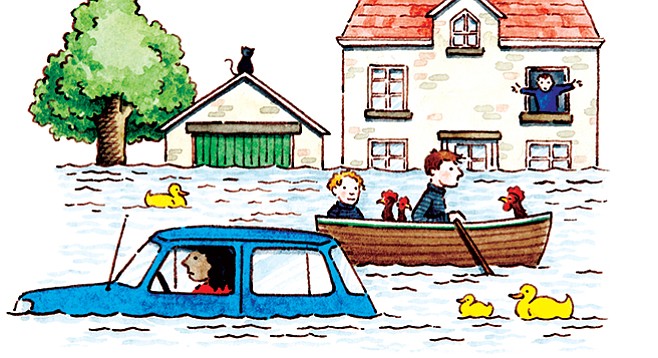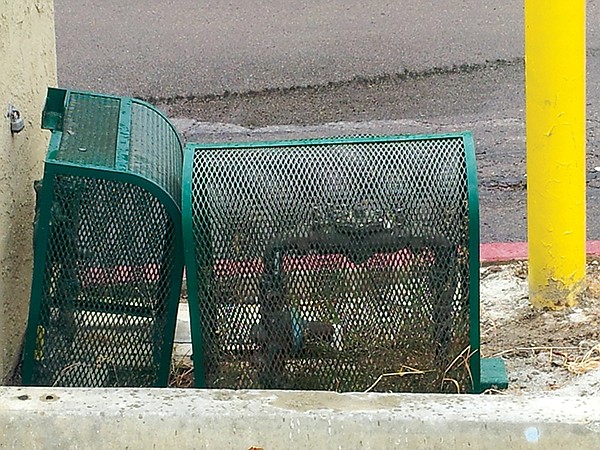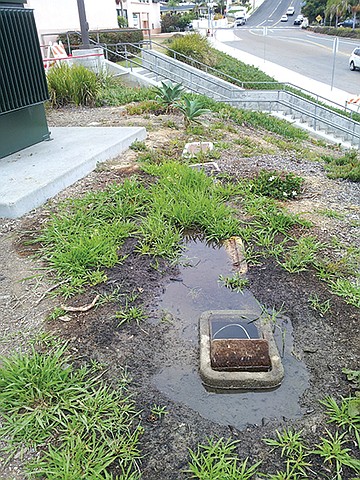 Facebook
Facebook
 X
X
 Instagram
Instagram
 TikTok
TikTok
 Youtube
Youtube

Chrissy Seigler noticed a leaky water main valve on the sidewalk in front of her Point Loma home. The water was seeping out from the lid and dribbling down the street.
In early June, Seigler called the emergency hotline on the City of San Diego Public Utilities Department website to report the leak. Seigler claims that “four or five days later” a repair crew came out to her home and fixed it.
“It was working okay for just a month or so, but then it busted again,” Seigler says.
Again, she called to report the leak and the public utilities water workers came back out to Seigler’s home.
“They looked at it and they said, ‘It’s not just gushing out, it’s just at the top,’” Seigler says. “I said, ‘Yeah, but look, it’s on the street.’ He said, ‘It’s on our side. It’s okay because it’s not that serious of a leak.’”
The man heading up the work crew told her not to worry about it because she wasn’t being charged for the water waste and then they left without fixing it.
According to a staffer at the public utilities department, water-leak reportage has increased in the months since Governor Brown declared a drought state of emergency in January. Although she does not know the total number of leak reports that come in to the department as a whole, she estimates that she takes five to six leak reports per day.
“There’s a lot more people calling and taking pictures of leaks that are happening from sprinkler heads and runoff,” she says.
In an email to the Reader, Arian Collins, senior public information officer with the City of San Diego, wrote, “More people reporting leaks is helpful. Whether they are leaks on the City water system or from private property, or if it’s a case of water waste, the City wants to know in order to respond and fix the issue.”
The public utilities worker claims that whether the property where the leak originates is commercial, private, or city-owned makes no difference.
“The worst leak possible first,” she says. “The leaks are prioritized based on the type of leak it is. Main breaks, of course, are first, and then water calls. And leaks are prioritized based on workload. They have to follow up within 24 to 48 hours to make the initial investigation, and then it’s up to them or their supervisor to determine which property gets serviced first.”
In his email, Collins explains that although the city wants to be made aware of all leaks, not all investigations will result in repairs by the public utilities department. Some are determined to be “property site issues” that must be fixed by the property owner.
“Most calls are about legitimate leaks,” he wrote, “however, not all leaks are from the City’s water system. Some are from private property, and some are the result of over-irrigation drainage.”

On Tuesday, July 7, a leak was reported from a water main behind the Vons shopping center on Midway Drive. One witness estimated that the valve was leaking approximately one cup every 30 seconds, which adds up to 180 gallons per day. According to the aforementioned public utilities worker, the water department investigated on July 8 and discovered that the leak is a “private backflow behind Vons, so we do not make repairs to those.”
“When they did the investigation they said it was a property site issue,” she says. “They said they left the findings, so they did [alert] the address at the property. They made them aware that there’s a leak at the backflow, so it is now their responsibility to have that fixed.”
On August 18, the leak still ran.
Other reports are more questionable and less clear as to who is responsible.

Also on July 7, a citizen reported a leak at Dana Middle School on Narragansett Avenue in Loma Portal, where a water-main valve box stood filled with water and the ground around it was a soggy mess.
According to the records the staffer pulled up, the public utilities department investigated the issue and found that the standing water was not the result of a leak but rather was from irrigation runoff at the school.
Sometime at the end of July or early August, the leak was repaired and the site is now dry.
Regardless of where other investigations in her neighborhood have led, Chrissy Seigler remains baffled as to why her leak was left to run after it was investigated. Although the public utilities workers tried to assure her that she need not worry because she wasn’t being charged, she remained concerned.
Seigler was so concerned by the “don’t worry about it” response that on July 6 she called to report the leak again. But this time, she decided to raise the stakes.
“I threatened them that we’re going to get it on the news,” she said on July 7, “and they’re out today, they’re repairing it. They came out pretty fast.”


Chrissy Seigler noticed a leaky water main valve on the sidewalk in front of her Point Loma home. The water was seeping out from the lid and dribbling down the street.
In early June, Seigler called the emergency hotline on the City of San Diego Public Utilities Department website to report the leak. Seigler claims that “four or five days later” a repair crew came out to her home and fixed it.
“It was working okay for just a month or so, but then it busted again,” Seigler says.
Again, she called to report the leak and the public utilities water workers came back out to Seigler’s home.
“They looked at it and they said, ‘It’s not just gushing out, it’s just at the top,’” Seigler says. “I said, ‘Yeah, but look, it’s on the street.’ He said, ‘It’s on our side. It’s okay because it’s not that serious of a leak.’”
The man heading up the work crew told her not to worry about it because she wasn’t being charged for the water waste and then they left without fixing it.
According to a staffer at the public utilities department, water-leak reportage has increased in the months since Governor Brown declared a drought state of emergency in January. Although she does not know the total number of leak reports that come in to the department as a whole, she estimates that she takes five to six leak reports per day.
“There’s a lot more people calling and taking pictures of leaks that are happening from sprinkler heads and runoff,” she says.
In an email to the Reader, Arian Collins, senior public information officer with the City of San Diego, wrote, “More people reporting leaks is helpful. Whether they are leaks on the City water system or from private property, or if it’s a case of water waste, the City wants to know in order to respond and fix the issue.”
The public utilities worker claims that whether the property where the leak originates is commercial, private, or city-owned makes no difference.
“The worst leak possible first,” she says. “The leaks are prioritized based on the type of leak it is. Main breaks, of course, are first, and then water calls. And leaks are prioritized based on workload. They have to follow up within 24 to 48 hours to make the initial investigation, and then it’s up to them or their supervisor to determine which property gets serviced first.”
In his email, Collins explains that although the city wants to be made aware of all leaks, not all investigations will result in repairs by the public utilities department. Some are determined to be “property site issues” that must be fixed by the property owner.
“Most calls are about legitimate leaks,” he wrote, “however, not all leaks are from the City’s water system. Some are from private property, and some are the result of over-irrigation drainage.”

On Tuesday, July 7, a leak was reported from a water main behind the Vons shopping center on Midway Drive. One witness estimated that the valve was leaking approximately one cup every 30 seconds, which adds up to 180 gallons per day. According to the aforementioned public utilities worker, the water department investigated on July 8 and discovered that the leak is a “private backflow behind Vons, so we do not make repairs to those.”
“When they did the investigation they said it was a property site issue,” she says. “They said they left the findings, so they did [alert] the address at the property. They made them aware that there’s a leak at the backflow, so it is now their responsibility to have that fixed.”
On August 18, the leak still ran.
Other reports are more questionable and less clear as to who is responsible.

Also on July 7, a citizen reported a leak at Dana Middle School on Narragansett Avenue in Loma Portal, where a water-main valve box stood filled with water and the ground around it was a soggy mess.
According to the records the staffer pulled up, the public utilities department investigated the issue and found that the standing water was not the result of a leak but rather was from irrigation runoff at the school.
Sometime at the end of July or early August, the leak was repaired and the site is now dry.
Regardless of where other investigations in her neighborhood have led, Chrissy Seigler remains baffled as to why her leak was left to run after it was investigated. Although the public utilities workers tried to assure her that she need not worry because she wasn’t being charged, she remained concerned.
Seigler was so concerned by the “don’t worry about it” response that on July 6 she called to report the leak again. But this time, she decided to raise the stakes.
“I threatened them that we’re going to get it on the news,” she said on July 7, “and they’re out today, they’re repairing it. They came out pretty fast.”
Comments